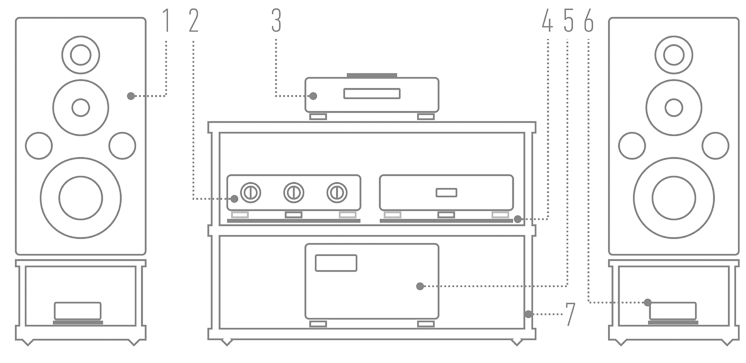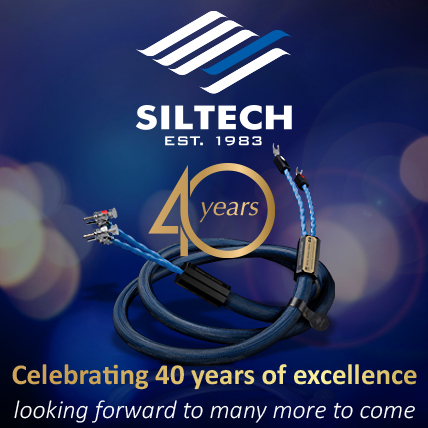|
POWER AMPLIFIER • monoblock YPSILON ELECTRONICS
Manufacturer: YPSILON ELECTRONICS |

|
Review
text WOJCIECH PACUŁA |

|
No 255 August 1, 2025 |
ONE THING YOU CAN'T DENY YPSILON is a grand scale of operation. When we look at its offerings (it's an amplifier manufacturer), we'll understand where a large portion of the aluminum imported into Europe from Asia, Africa, Australia or South America ends up. Besides, it's not just aluminum, but also copper, which is used for winding transformers. 
For example, let's take a look at their top-of-the-line amplifier, the Hyperion monoblocks. First presented at the High End 2016 exhibition in Munich, they weigh 95 kg each and measure 425 x 635 x 300 mm. They are powerful. Their enclosures are made of thick aluminum plates, and inside we'll find a huge power transformer, two coupling transformers, two chokes and another power transformer. The tested amplifier is a 100W Class A device built using hybrid technology – with a tube input stage and a transistor current section. However, the given power is not the maximum power. This company's amplifiers operate similarly to Accuphase Class A devices. These are classic Class AB amplifiers, but with a very high quiescent current, which means a large portion of their operation falls within the Class A range. After crossing this threshold, the device seamlessly transitions to Class B operation. In this way, the Hyperion delivers up to 370 watts into an 8-ohm load, 650 watts into 4 ohms, and a whopping 1150 watts into 2 ohms. The company writes the following about its amplifier:
This brings us to the hybrid nature of the tested amplifier. In the case of integrated designs, it is occasionally used. Tubes are placed at the input due to their linearity, and transistors (or integrated circuits) at the output, providing the required power. In the case of power amplifiers, this solution is much less common, which doesn't mean it's never encountered. Let's recall the → TENOR AUDIO 175S https://highfidelity.pl/@main-467&lang= , the PrimaLuna Evo 300, and even the Rogue Audio DragoN with a Class D output stage. Ypsilon took a maximalist approach here. The input section uses a 6H30 dual triode, still Soviet production, which can also be found in the output stage of the Ayon Audio CD-35 player and in its D/A converters. Interestingly, in earlier designs, such as the Aelius, the Greek designers used the C3g pentode, which is much rarer than the C3m, which Ayon uses in the Spheris preamplifier. The input stage in the Hyperion has its own tube power supply, using an EZ81 and a choke, and is transformer-coupled to the input, providing a perfectly balanced input. 
The two halves of the input tube are connected in parallel using separate windings to provide independent paths for the bias current of each half. Let's add that instead of a 6H30, we can also use a 5687, for which a separate, unoccupied base is provided. With this tube, we'll get slightly different sound, but it also has higher distortion than the 6H30. A second coupling transformer is used between the stages. It allows for a reduction in impedance and the elimination of the capacitor from the circuit. It has its issues, but if it weren't there, the input stage would have to be much more complex. Its winding wire is made of silver. The output stage is based on MOSFET transistors operating in a push-pull mode. The device does not have global feedback. In a nutshell – it’s audiophile high-end classics in a modern edition. ▌ THE LISTENING SESSION THE WAY WE LISTENED • The Ypsilon Hyperion power amplifiers were tested in the "High Fidelity" reference system. They were compared to a reference amplifier, the Soulution 710 transistor power amp – in both cases, signal was supplied from the Ayon Audio Spheris Evo line preamplifier. During the test, I used the Ayon Audio CD-35 HF Edition SACD player and the Lumin T3 file player as sources. 
Signal between the preamplifier and amplifiers was transmitted via a Siltech Single Crown RCA interconnect and delivered to the speakers by a Crystal Cable Da Vinci speaker cable. The amplifiers powered Harbeth M40.1 speakers. During the test, they were standing on the floor in front of the system. Their power supply requires 20A cables with plugs, which I didn't have. That's why, during the test, I listened to them with A.S.P. Reference Poseidon AC power cables. » ALBUMS USED IN THE TEST ⸜ a selection
⸜ AKIRA TANA TRIO, A New Picture I, ShinRec SRCD-8030, CD ⸜ 2024. DID I HAVE ANY EXPECTATIONS WHEN I SAT DOWN TO LISTEN to the Hyperions? – Of course! They are some of the most expensive amplifiers I've had at home, huge ones from a reputable company… It’s impossible not to have any thoughts in your head before listening to them. Besides, I had heard them at many listening sessions in Munich during the High End show. So, I had high expectations. It turned out that reality is actually more interesting than they are. The Greek monoblocks sound so different from most of the high-end equipment I've had, that it was quite easy for me to form my initial conclusions. It was only after some time that it turned out that what had seemed simple wasn't, and what had been clear was becoming increasingly complex, and therefore difficult to express neatly in words. However, what I started and finished the test with could be summarized in the following statement: these devices are incredibly resolving and differentiate musical material in an outstanding way. Their band is very wide and its edges have the same energy as the midrange. The latter sets the tone for the whole thing, but every element is buzzing with events, everything here has its weight, and nothing is covered up or forgotten. The point is that the Ypsilon monoblocks deliver sound directly, without the hesitation we get with most other products of this type, i.e., without the subtle "film" between the sound and us that is present even in the best amplifiers, like the Kondo Ongaku or my Soulution. Sometimes, as in the case of the latter, it's a film that allows us to extract subtleties from the sound that we hadn't heard before, while also presenting everything politely and with a kind of reverence. But – still... The Hyperion monoblocks play music in a much more direct way than any amplifier I've ever owned. And they never get annoying. It's the way they play that reminded me of my visit to Jack Gawłowski's studio and watching the mixing and mastering of the track Pielgrzym from the album of T.LOVE; more → HERE. There was both an insight into the mix and a sense of wholeness, which perhaps even dominated everything else. It was like I was the sound director and the band was playing in the studio in front of me, warming up before the actual recording. Also while listening to the recordings from the AKIRA TANA TRIO album A New Picture I, recorded 100% "live" without editing, using just two microphones, I couldn't help but appreciate how phenomenally the tested amplifiers convey energy and how precisely they capture the leading edge of the attack. That's why the sound seems so fast, the attack is instantaneous – not through artificially exaggerating the rising phase, but through its ultra-precise representation, meaning in its fullness, density, in a cloud of information about what's happening there. This makes the outline of sound sources exceptionally clear. We have precisely depicted shapes here, and various subtleties of the game are also excellently communicated. It's not just mindless drumming; it's multi-dimensional, interesting sound, but not too clear at all. Perhaps I should have started with this, but it's never too late: despite their absolutely perfect clarity and speed, the amplifiers we're testing are not clear. The first few bars from the album I just mentioned left a sweet taste on my tongue; they were almost warm. That feeling passed after a moment, but not completely. 
Because the Hyperion monoblocks aren't devices that can be "caught" on this or that, they require a long listening session to truly understand what they are and what they offer. Have I not just written that I knew what they were up to right away? – Well... Not entirely. Even I was surprised that, after a while, I started to find things in that sound that I had missed at first. It was like peeling – to quote Shrek – an onion. You think you know what you're looking at, but you really have no idea how much there is underneath. And here's something that could be called reliability and credibility: in short – high fidelity. TERUO NAKAMURA takes no prisoners on the album Unicorn from Three Blind Mice. This is fusion music, where we have everything we love about it: experiments, classic jazz, wildness and melody. The Greek amplifiers showed it in all its glory – even better than my Soulution 710. The sound was denser and clearer at the same time, both faster and warmer, with more pronounced bass, but bass that is better articulated and not at all exaggerated. |
It was something like a direct transmission to my body. Not even head, because there was a lot of emotion involved, not just "understanding". I don't know if you remember the song Transmission Into Your Heart by the Polish band Houk? That's exactly how I felt when I heard the bass from that album, when the drummer hit the snare drum, or when the piano came in later in the mix. But it wasn't just a mechanical transfer of sounds from the speakers to me. And that's what I found most interesting about the tested devices. After the stunning success of the song Girl From Ipanema, ASTRUD GILBERTO had the door open to a career in the USA, which is to say, a global career. She took advantage of this, releasing a series of albums in subsequent years. One of them was the album The Shadow of Your Smile, recorded in 1964 and released by Verve Records in 1965. I'm bringing it up because it's radically different from the two mentioned earlier, and also because the Hyperion device communicated this difference as early as at the stage of noise that opens the title track. In the sense that I got, right away, a broad perspective, large phantom sources, but above all, delicacy. What I said earlier about the direct transmission of energy, as if there was no air in the room, just a copper conductor, was clear here as well. This time, however, this directness catered to a different kind of musical sensitivity. While the dynamics were previously explosive and the soundstage comparable to listening to live music, now it was clear that this was a studio recording, produced in a specific way and intended to convey different emotions, such as melancholy, sadness, the (still) hot air from the Brazilian coast. 
The album was played with great sensitivity by the tested amplifiers. I remember this is the way that SET tube amplifiers play with my Harbeth loudspeakers, e.g., the abovementioned Ongaku, Phasemation, or → OCTAVE JUBILEE 300B. Yes, it's hard to believe, but the Ypsilons showcased Gilberto's vocals, which are so fleeting, almost esoteric, even feminine, innocent, yet also full of passion in the way they deserve. This allowed me to focus not on their shortcomings, but on the melody, the atmosphere. Besides, the same could be said about the amplifiers themselves, as if their size and reserve of power, dynamics and resolution were so great that they could withdraw behind the music without feeling like they were missing out on anything, like no one "sees" them. Exactly – they are devices that don't manifest their presence, even though they play in such an open way. Even my Soulution 710 does this to some extent, although it's very cautious in this regard. The monoblocks play in a more open way across a wider bandwidth, but they are by no means more aggressive as a result. Due to its excellent internal consistency, the sound is almost calm and pleasant; in other words – not attacking, more assisting. This assistance would involve delivering sound in its fullness, its dynamic uniqueness, as during a live event, but without exaggeration, without the need to prove "I can do it." And then there's the outstanding spaciousness and holography. When I started listening, I had to check if I had connected the speakers in phase. The message was exceptionally extensive and without limitations. As it turned out – no, everything was fine, and the impression of power came from how the Hyperion monoblocks convey even the smallest details in a full cloud of sounds, making the message so extensive. Because that's what space is all about, the resolution of elements at the lowest levels. This was evident even from recordings like HEART's 2003 album Live in Seattle, which captured their last concert in Seattle during the "Summer of Love Tour" in the summer of 2002. The version I have is special, it's a Test Press SACD, but even that doesn't hide the fact that it's a typical multi-track recording without any particular depth. Despite that, it was cool, dynamic and attractive this time. The bass was a bit muffled and not very deep, but that didn't bother me. The midrange was more important, with Nancy Wilson's vocals and guitars, where the most action was happening. While the Hyperion device played jazz recordings in a very open way, because that's what the material called for, it played this album in a subdued manner, without too many details – again, because that's what the recording is like. It's a chameleon amplifier. That means it adapts to the music, not the other way around. There's no pressure felt in his actions. If we have classic jazz, it goes in that direction. The sound will then be clear, detailed, ultra-dynamic, with perfectly rendered sound sources. But if we play contemporary club music with it, let it be TIËSTO, ODD MOB and GODBOYS in the track Won’t Be Possible, we'll instantly get into the vibe with the people in the enclosed space, where the bass is compressed in a way we only experience at large outdoor concerts. As for the hyper-spatial music in the song Crystaline by the English band MARCONI UNION, it literally lifted me off the ground at one point. As if it was no problem for these amplifiers to dive into the depths of the bass, and in the next second lift off the ground in a soaring glide, beautiful, smooth, but also full of nuances and details that make it not just a boring repetition of a single note, but something more, what good ambient music can be. ▌ Conclusions The YPSILON HYPERION amplifiers are the best devices of their kind I've had at home, perhaps with the exception of the Kondo Ongaku and Kondo Gakuoh II integrated amplifiers, which showed even "more" of something; more → HERE, though not in everything. I didn't want to flaunt this earlier so as not to impose a perspective on you, but that's how the best SET tube amplifiers play – in my opinion. But here we have even more freedom resulting from the available power. And the base is better controlled, defined, and at the same time more strongly saturated. 
The power I'm talking about isn't brute force, but is intelligently distributed, used to highlight aspects of the reproduced sound, rather than aspects of the amplifier's own sound. It's somewhere there, but it's very deeply hidden so it doesn't dominate. So, I often felt like I was sitting in a mastering studio, a good studio, I might add. It was direct, dynamic and energetic sound, and also exceptionally musical. It's not just a machine, but something like a "ghost in the machine". The device closest to it would be the 711 Mk II amplifier from the Swiss company FM Acoustics; more → HERE. But even so, the Greek amplifier shows something else that is a notch higher. This is an outstanding device, one of the best I've ever had the pleasure of using in my life. Without candy-like sound, yet sweet, distinct and never "piercing". It's just a REFERENCE. From us, the ˻ GOLD FINGERPRINT ˺, best of the best of our “Editor’s Awards” ▌ DESIGN THE YPSILON HYPERION is a monophonic power amplifier. This type of a device is called a monoblock, and you need two for stereo listening. The device is very large and heavy: 425 x 635 x 300 mm and 95 kg/piece. Its enclosure is made of aluminum plates reinforced at the joints by aluminum beams. The front is thicker, and very large radiators with corrugated fins are placed on the sides. Corrugation increases the effective cooling surface for the same size. To prevent users from being injured by its sharp edges, the case has a slightly larger outline and covers the edges. On the front of the device we only have a long, blue backlight and the logo. There's more happening in the back. We have RCA and XLR inputs there, as well as a switch that allows you to disconnect the electrical ground from the enclosure. Both inputs are equivalent because the input circuit is unbalanced. There are also two pairs of very good speaker terminals, making bi-wiring easier. The gold-plated RCA input (WBT-0210) and speaker terminals are from WBT (WBT-0703) and belong to the Nexten series, which minimizes the amount of metal used. There are also two triggers on the back that can be used to remotely turn the device on and off, for example from a preamplifier. The device's interior is both simple and impressive. In the middle, a power supply based on a powerful transformer is located, from which four secondary windings emerge. Each branch (plus and minus) has its own power supply. The transformer has a classic EI core construction, and we've gotten used to manufacturers advertising their amplifiers by saying they use toroidal transformers. Apparently, Ypsilon has a different idea about sound. The transformer is paired with a bank of 24 Mundorf capacitors with a total capacitance of 112,800 µF. They were soldered to a board screwed above the choke, which is part of the final transistor power supply. These are MOSFET (metal-oxide-semiconductor field-effect transistor) transistors: Vishay IRFP240 and IRFP9240. Each monoblock uses six pairs of transistors. They are controlled by bipolar transistors. Similar to the Aelius model, Hyperion's output is of "float" type – neither the positive nor the negative terminal is grounded. The amplifier is protected using a thyristor-based circuit. Therefore, there is no relay in it. If a short circuit occurs at the output, the load is less than 1 Ω, or the system detects a DC voltage at the input, the amplifier will automatically shut down. After the problem is resolved, turning the amplifier back on restores the output signal. 
A separate module is dedicated to the tube input – the Hyperion is a hybrid amplifier. It uses a Soviet 6H30 tube with its own power supply, which has a shielded C-core transformer with silver winding wire, a choke, and an EZ81 rectifier tube, which is a full-wave rectifier. In the tested unit, it's a Mullard NOS type tube. An interesting fact is that next to the amplifying tube is an empty base designed for a different type of a tube if we feel like changing something in the device. The internal connections are made using custom-drawn silver wire ordered by Ypsilon, coated with Teflon. ● ▌ Technical specifications (according to the distributor)
Output power: 370 W RMS/8 Ω, 650 W RMS/4 Ω, 1150 W RMS/2 Ω 
THIS TEST HAS BEEN DESIGNED ACCORDING TO THE GUIDELINES adopted by the Association of International Audiophile Publications, an international audio press association concerned with ethical and professional standards in our industry, of which HIGH FIDELITY is a founding member. More about the association and its constituent titles → HERE. |

|
Reference system 2025 |
|
 1) Loudspeakers: HARBETH M40.1 |REVIEW| 2) Line preamplifier: AYON AUDIO Spheris III Linestage |REVIEW| 3) Super Audio CD Player: AYON AUDIO CD-35 HF Edition No. 01/50 |REVIEW| 4) Stands (loudspeakers): ACOUSTIC REVIVE (custom) |ABOUT| 5) Power amplifier: SOULUTION 710 6) Loudspeaker filter: SPEC REAL-SOUND PROCESSOR RSP-AZ9EX (prototype) |REVIEW| 7) Hi-Fi rack: Hi-Fi rack: finite elemente MASTER REFERENCE PAGODE EDITION Mk II, more → HERE |
|

|
Cables Analog interconnect SACD Player - Line preamplifier: SILTECH Triple Crown (1 m) |ABOUT|» ANALOG INTERCONNECT Line preamplifier → Power amplifier: Siltech ROYAL SINLGE CROWN RCA; review → HERE Speaker cable: SILTECH Triple Crown (2.5 m) |ABOUT| |

|
AC Power Power cable | Mains Power Distribution Block - SACD Player: SILTECH Triple CrownPower (2 m) |ARTICLE| » POWER CABLE Mains Power Distribution Block → Line preamplifier: Acoustic Revive ABSOLUTE-POWER CORD, review → HERE » POWER CABLE Mains Power Distribution Block → Power amplifier: Acoustic Revive ABSOLUTE-POWER CORD, review → HERE Power cable | Power Receptacle - Mains Power Distribution Block: ACROLINK Mexcel 7N-PC9500 (2 m) |ARTICLE| Power Receptacle: Acoustic Revive RTP-4eu ULTIMATE |REVIEW| » ANTI-VIBRATION PLATFORM under Acoustic Revive RTP-4eu ULTIMATE: Graphite Audio CLASSIC 100 ULTRA, review → HERE Power Supply Conditioner: Acoustic Revive RPC-1 |REVIEW| Power Supply Conditioner: Acoustic Revive RAS-14 Triple-C |REVIEW| Passive filter EMI/RFI: VERICTUM Block |REVIEW| |

|
Anti-vibration Speaker stands: ACOUSTIC REVIVE (custom)Hi-Fi rack: finite elemente MASTER REFERENCE PAGODE EDITION Mk II, more → HERE Anti-vibration platforms: ACOUSTIC REVIVE RAF-48H |ARTICLE| » ANTI-VIBRATIONAL FEET: |

|
Analogue Phono preamplifier: Phono cartridges:
Clamp: PATHE WINGS Titanium PW-Ti 770 | Limited Edition Record mats:
|

|
Headphones » HEADPHONE AMPLIFIER: Leben CS-600X, review → HEREHeadphones: Headphone Cables: Forza AudioWorks NOIR HYBRID HPC |
main page | archive | contact | kts
© 2009 HighFidelity, design by PikselStudio,
projektowanie stron www: Indecity


























